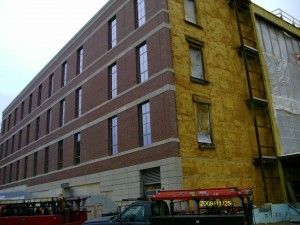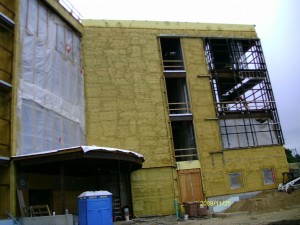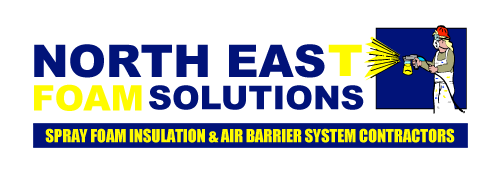Air Vapor Barrier Systems
 As a building science resource to the customers we serve, North East Foam Solutions strives to provide the best quality products and service to contractors, architects, and engineers.
As a building science resource to the customers we serve, North East Foam Solutions strives to provide the best quality products and service to contractors, architects, and engineers.
What is an “air barrier”?
An air barrier is a material or an interconnected assembly of materials that retard the passage of air. An air barrier may or may not be vapor permeable.
What perm rating should an air barrier have?
Air barriers are often confused with vapor retarders. Perm ratings are attributed to vapor retarders, not air barriers. An air barrier may or may not be vapor permeable. An air barrier’s performance is measured in air leakage, not perms. According to the Air Barrier Association of America (ABAA) an air barrier material must provide an air leakage rate of less than 0.02 L/s*m2 at 75 Pa pressure difference.
What is a non-permeable air barrier?
Non-permeable air barriers act as air, vapor and rain barriers in one membrane. Typically positioned within the wall cavity, they resist air leakage, offer very low vapor permeance and are watertight.
What is a vapor-permeable air barrier?
Vapor-permeable air barriers keep air and water out, but feature a high vapor permanence that allows water vapor to escape. They offer watertight protection against air leakage and can be positioned anywhere within the wall assembly.
Won’t an air barrier keep the building from “breathing”, thereby causing mold and sick building syndrome?
A building’s occupants do require fresh air for health and well-being. The best way to provide fresh air to the occupants is the use of the ventilation system, which is already defined by ASHRAE code. Some buildings also have operable windows, which can be opened during fair weather. A building should not “breathe” through uncontrolled air leakage. Uncontrolled leakage of air across the building envelope often causes a number of serious problems, including:
• Occupant discomfort from drafts and cold/hot spots
• Unwanted transfer of odors or contaminants from one part of the building to another
• Prevention of effective function of the HVAC system
• Increase in energy costs
• Condensation within the building envelope, which can cause damage to the building components and MOLD!
Therefore, the building “breathing” by means of air leakage generally does more harm than good. A properly-installed air barrier makes a more comfortable, efficient and long-lasting building.
 Does taping the joints between sheathing or insulation board make an air barrier?
Does taping the joints between sheathing or insulation board make an air barrier?
Since most sheathing itself is an air barrier, taping the joints makes a continuous wall air barrier. Tape has many exposed edges where cycles of heat, cold and moisture will work the bond loose over time. Also, workmanship in taping the joints is critical as any wrinkle or fishmouth would present a breach in the system. Then, there is still a requirement to tie the wall air barrier to the roof and foundation.
Can spray foam Insulation be used as an air barrier?
Closed-cell spray polyurethane foam is unique in serving as both as an insulation system and as an air barrier in a single product application. This is primarily due to the fact that is a seamless and fully adhered system.
